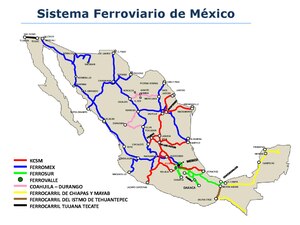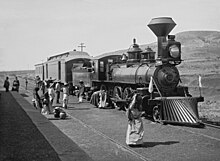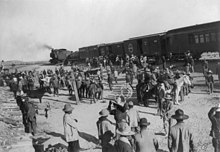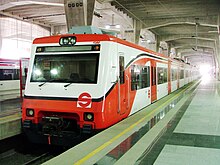| This article needs to be updated. Please help update this article to reflect recent events or newly available information. (January 2025) |

Mexico has a freight railway system owned by the national government and operated by various entities under concessions (charters) granted by the national government. The railway system provides freight and service throughout the country (the majority of the service is freight-oriented), connecting major industrial centers with ports and with rail connections at the United States border. Passenger rail services were limited to a number of tourist trains between 1997, when Ferrocarriles Nacionales de México suspended service, and 2008, when Ferrocarril Suburbano de la Zona Metropolitana de México inaugurated Mexico's first commuter rail service between Mexico City and the State of Mexico. This is not including the Mexico City Metro, which started service in 1969.
History
Construction


Mexico's rail history began in 1837, with the granting of a concession for a railroad to be built between Veracruz, on the Gulf of Mexico, and Mexico City. However, no railroad was built under that concession.
In 1857, Don Antonio Escandón secured the right to build a line from the Atlantic Ocean port of Veracruz to Mexico City and on to the Pacific Ocean. Revolution and political instability stifled progress on the financing or construction of the line until 1864, when, under the regime of Emperor Maximilian, the Imperial Mexican Railway Company began construction of the line. Political upheaval continued to stifle progress, and the initial segment from Veracruz to Mexico City was inaugurated nine years later on January 1, 1873 by President Sebastián Lerdo de Tejada.
President Lerdo and his successor Porfirio Díaz encouraged further rail development through generous concessions that included government subsidies for construction.
Impacts of the Diaz Administration

At the beginning of his first term Díaz inherited 398 miles (640.5 km) of railroads consisting almost exclusively of the British-owned Mexican Railway. By the end of his second term in 1910, Mexico boasted 15,360 miles (24,720 km) of in-service track, mostly built by American, British and French investors.
From a small start, the railway network expanded significantly, linking many parts of the country previously isolated. The Interoceanic Railway linked Mexico City to the port of Veracruz; the Monterrey and Mexican Railroad linked that northern city with the Gulf Coast port of Tampico; the Southern Pacific of Mexico linked west coast cities from Guaymas to Mazatlan; the Sonora Railway linked Nogales to the port of Guaymas; and the Mexican Central Railroad went north to the U.S. border at El Paso, Texas. The British invested £7.4 million in railways during the decade of the 1880s, jumping to £53.4 million in 1910s. The decade-total of new investment in mining went from £1.3 million in 1880s to £11.6 million in 1910s. Investments in land and other properties rose from near zero in 1880s to £19.7 million in 1910s. The totals reached £135 million, almost as much as the United States.
In the late nineteenth century, railroads were becoming symbols of centralized power, political and monetary, in Mexico. The institution of rail systems in the country required new regulations and legislation for residents and railroad development. There was great debate surrounding the early railroads in Mexico, regarding how much they were truly improving the country. Scholars view the rail systems as simultaneously encouraging rapid economic growth and commercial relationships while displacing the population and creating widespread poverty within the sectors that were run by the rail systems. Porfirio Díaz had developed his country but at the expense of his people. Much of the criticism levied toward Díaz regarded his rapid modernization in a country still rebuilding from its internal conflicts.
Growing nationalistic fervor in Mexico led the Díaz administration to bring the bulk of the nation's railroads under national control through a plan drafted by his Minister of Finance, José Yves Limantour. The plan, implemented in 1909, created a new government corporation, Ferrocarriles Nacionales de México (FNM), which would exercise control of the main trunk rail lines through a majority of share ownership.
Nationalization
Ferrocarril Nacional de México, incorporated in Colorado in 1880 as Mexican National Railway, was built on narrow-gauge railroad tracks under the instruction of General William Jackson Palmer of the Denver and Rio Gange Railway. The main line from Mexico City to Nuevo Laredo was constructed using the 3-ft narrow gauge tracks. From Saltillo, Coahuila to Concepción del Oro, Zacatecas, the FCNM built narrow-gauge tracks in 1903 to service mining operations. A likely reason for this, aside from General Palmer’s preference for the narrow gauge in use of mining, is that narrow gauge is more cost efficient. In 1901, however, the tracks began conversion to standard gauge.
The rail system deteriorated greatly from neglect during the period of the Mexican Revolution. Following the Revolution, the entirety of the Mexican rail system was nationalized between 1929 and 1937.
During the 1950s, the Yucatan Peninsula experienced successful development as it integrated into the national network. In Oaxaca, on June 26, 1958, union workers from the Sindicato de Trabajadores Ferrocarrileros de la República Mexicana (STFRM), led by railroad worker and union activist Demetrio Vallejo, began a series of strikes seeking higher wages. When their demands remained unmet, a system-wide strike was called on January 18, 1959. The strike escalated on the afternoon of January 25 when Ferrocarriles Nacionales (the National Railway) officially began their strike action. By 10 a.m. the following day, an agreement had been reached that included medical care for workers' families, higher wages, and an allocation of 30 million pesos for the construction of affordable rental housing for the workers.
In 1987 the government merged its five regional railroads into FNM. During the later period of national ownership, FNM suffered significant financial difficulties, running an operating deficit of $552 million (37 percent of its operating budget) in 1991. Competition from trucking and shipping decreased railroad's share of the total freight market to about 9 percent, or about half of rail's share a decade earlier.
Privatization
In 1995, the Mexican government announced that the FNM would be privatized and divided into four main systems. As part of the restructuring for privatization, FNM suspended passenger rail service in 1997.

In 1996, Kansas City Southern (KCS), in a joint venture with Transportacion Maritima Mexicana (TMM), bought the Northeast Railroad concession that linked Mexico City, Monterrey, the Pacific port at Lázaro Cárdenas and the border crossing at Laredo. The company was initially called Transportación Ferroviaria Mexicana (TFM), but was renamed Kansas City Southern de México (KCSM) in 2005 when KCS bought out TMM's interests. KCS's systems in the United States and Mexico jointly form end-to-end rail system linking the heartlands of Mexico and the United States.
The Northwest Railroad concession, connecting Mexico City and Guadalajara with the Pacific port of Manzanillo and various crossings along the United States border was sold to a joint venture between Grupo México and Union Pacific Railroad in 1998 during the presidency of Dr. Ernesto Zedillo (which later occupied the position of Director of the Board of Union Pacific). The company operates as Ferrocarril Mexicano or Ferromex. Ferromex's freight volumes have increased; it hauled a record 22,365 million tonne-km in the first 6 months of 2010. Also, Ferrosur, the railroad serving Mexico City and cities/ports southeast of Mexico City, hauled their own record 3,565 million tonne-kilometers.
There were two southern concessions, merged in 2000 to form Ferrosur. Ferrosur operates the line between Mexico City and the Gulf of Mexico port of Veracruz. In 2005, Ferrosur was bought by Ferromex's parent company. KCSM challenged the acquisition and the merger failed to receive regulatory approval. However, in March 2011, a tribunal ruled in Grupo México's favor, and the merger was permitted.
The three major Mexican railroads jointly own Ferrocarril y Terminal del Valle de México (Ferrovalle) which operates railroads and terminals in and around Mexico City.
Revival of passenger service
In 2006, the Secretariat of Communications and Transport of Mexico proposed a high-speed rail link that would have transported passengers from Mexico City to Guadalajara, Jalisco, with stops in the cities of Querétaro, Guanajuato, Leon and Irapuato, along with a branch running from the port city of Manzanillo to Aguascalientes. The train would travel at 300 km/h, and would allow passengers to travel from Mexico City to Guadalajara in just 2 hours at an affordable price (the same trip by road takes 7 hours). The network was foreseen to eventually connect to Monterrey, Chilpancingo, Cuernavaca, Toluca, Puebla, Tijuana, Hermosillo, Cordoba, Veracruz, Oaxaca, Colima, Zacatecas, Torreon, Chihuahua, Puebla, San Luis Potosi, Mexicali, Saltillo, and Acapulco by 2015. The whole project was projected to cost 240 billion pesos, or about 25 billion dollars. Despite Mexican billionaire Carlos Slim's expressed interest in investing in high-speed rail, no progress was made on the proposal.
President Enrique Peña Nieto proposed a return to services of intercity trains. His administration's proposals included the Toluca–Mexico City commuter rail, which successfully launched construction in 2014 and went into service in 2023. They also included the Tren Maya, which would run throughout the Yucatan Peninsula, and whose construction eventually began in 2020, and a Mexico City-Querétaro high speed rail line.
A consortium of China Railway Construction Corporation, Prodemex, Teya and GHP was awarded the contract to build the Mexico City-Querétaro high speed rail, at a cost of $3.75 billion dollars. However, the contract was cancelled the following year due to a series of corruption scandals. In 2015, Mexico opened a new tender, which was again revoked, leading to the Mexican government paying China Railway Construction Corporation a 1.31 million USD indemnification. The project was revived in July 2023 as an extension of the Cuatitlan commuter rail, when the Mexican government signed an agreement with Canadian Pacific Kansas City Railroad to study the viability of a passenger rail line from Mexico City to the city of Queretaro.
In September 2018, President-elect Andrés Manuel López Obrador announced a US$7.4 billion plan to build a tourist and freight railway on the Yucatán Peninsula. The project, named the Tren Maya, began construction in 2020 and will connect Palenque to Cancún, but remains controversial with environmentalists and indigenous rights activists. The new service debuted in 2023 and marked yet another chapter in the intercity revival.
Railways


The major Class I freight railroads in Mexico include:
Short line railroads include:
- Baja California Railroad (BJRR)
- Ferrocarriles Chiapas-Mayab (FCCM)
- Ferrocarril y Terminal del Valle de México (Ferrovalle)
- Ferrosur (FSRR)
- Línea Coahuila Durango (LFCD)
- Tren Interoceánico
Passenger rail lines include:
- Chihuahua al Pacífico, a tourist train running through the Copper Canyon.
- Tequila Express, a tourist train running from Guadalajara, Jalisco to a tequila distillery in Amatitán.
- Tren Suburbano (commuter rail system in the Mexico City metro area. Under construction, will reach the Felipe Ángeles International Airport in 2024)
- El Insurgente (commuter rail system with 4 initial stations and 3 more opening in May 2024)
- Tren Maya, a passenger service on the Yucatán Peninsula with top speeds of up to 99 miles per hour (159 km/h).
- Line Z, a passenger on the Tren Interoceánico. Passenger service uses ex-Amtrak Amfleets, and ex-British Rail InterCity 125s.
Mass transit
Urban rail transit systems in Mexico include four light rail or rapid transit systems: The Guadalajara light rail system, the Mexico City Metro, the Xochimilco Light Rail line (in Mexico City) and the Monterrey Metro. In 2017, the Puebla-Cholula Tourist Train opened in Puebla City; service ended in December 2021.
Expansion
In January 2022, the Mexican Secretary of communications and transport approved a 180 Kilometer rail expansion in the Durango-Mazatlan corridor. It has an estimated cost of 1.2 billion dollars to revive and expand the abandoned corridor under a private-public partnership with the company Caxxor Group, as part of the USMCA agreement.
In December 2023, passenger service on Line Z was inaugurated as part of a larger scheme of expanding rail transport in Mexico. Though then-president Andrés Manuel López Obrador denied that the new Tren Interoceánico project was intended to compete with the Panama Canal, droughts affecting the canal mean Line Z may serve as an alternative rought for freight transport between the Atlantic and Pacific oceans.
Museums
There are several rail museums in Mexico including the Railway Museum in San Luis Potosi, the Old Railway Station Museum in Aguascalientes, Aguascalientes; a former station along the Interoceanic Railway of Mexico in Cuautla, Morelos which serves as a museum; the Museo de las Ferrocarilles en Yucatán is in Mérida, Yucatán; and the National Railway Museum in Puebla, Puebla. The former station in Monterrey, Nuevo Leon is now used as an art museum.
Railway links with adjacent countries
 United States – freight only – same 1,435 mm (4 ft 8+1⁄2 in) standard gauge
United States – freight only – same 1,435 mm (4 ft 8+1⁄2 in) standard gauge Guatemala – at Ciudad Tecún Umán, – break-of-gauge 1,435 mm (4 ft 8+1⁄2 in) standard gauge / 914 mm (3 ft) (rebuilt as standard gauge in 2019)
Guatemala – at Ciudad Tecún Umán, – break-of-gauge 1,435 mm (4 ft 8+1⁄2 in) standard gauge / 914 mm (3 ft) (rebuilt as standard gauge in 2019)
See also
- List of Mexican railroads
- List of street railways in Mexico (all-time, historical list)
- Transportation in Mexico
References
- Bazant, Jan (1977). A Concise History of Mexico from Hidalgo to Cardenas 1805–1940. New York: Cambridge University Press. p. 111. ISBN 0-521-29173-9.
- Fred Wilbur Powell, the Railroads of Mexico, 1921
- Coatsworth, John H. Growth Against Development: The Economic Impact of Railroads in Porfirian Mexico. DeKalb: Northern Illinois University 1981.
- Tenenbaum, Barbara A. and James N. McElveen, "From speculative to substantive boom: the British in Mexico, 1821–1911." in Oliver Marshall, ed. English speaking communities in Latin America (Macmillan, 2000): 51–79, at p 69.
- ^ Van Hoy, Teresa Miriam (2008). A social history of Mexico's railroads: peons, prisoners, and priests. Jaguar books on Latin America series. Lanham, Md.: Rowman & Littlefield. ISBN 978-0-7425-5327-9.
- ^ Powell, Fred Wilbur (1921). The railroads of Mexico. Rutgers University Libraries. Boston, Stratford.
- "Preserved Narrow Gauge Steam in Mexico 2012, Part 2". www.internationalsteam.co.uk. Retrieved April 11, 2024.
- "Railways - The World Factbook". www.cia.gov. Retrieved April 11, 2024.
- "Mexico's golden age of railways | Geo-Mexico, the geography of Mexico". geo-mexico.com. November 30, 2014. Retrieved April 22, 2024.
- "Mexican railroad workers strike for wages and union rights, 1958-1959 | Global Nonviolent Action Database". nvdatabase.swarthmore.edu. Retrieved April 22, 2024.
- "A record half". Railway Gazette International. London. September 9, 2010. Retrieved October 12, 2010.
- "Mexican Tribunal OKs Grupo Mexico Railroad merger". Reuters. March 28, 2011. Archived from the original on April 1, 2011.
- ^ Hawley, Chris (January 6, 2006). "Mexico reviving travel by train". Arizona Republic. Phoenix.
- ^ "Systra : Project for a Mexico City - Guadalajara High Speed Line. Rail transport engineering, public transport engineering". Archived from the original on May 1, 2011. Retrieved October 30, 2010.
- "Slim to invest in Santa Cruz" (Press release). Corporate Mexico. The America's Intelligence Wire. January 21, 2005.
- O‘Boyle & Graham, Michael & Dave (November 7, 2014). "Mexico scraps $3.75 bln China rail deal ahead of state visit". Reuters.
- "Mexico to pay China rail firm for cancelling project". BBC. May 22, 2015.
- Rogers, David (July 13, 2023). "Mexico revives Querétaro high-speed railway nine years after cancelling it". Global Construction Review. Retrieved December 12, 2023.
- Pskowski, Martha (February 22, 2019). "Mexico's 'Mayan Train' Is Bound for Controversy". CityLab. Retrieved February 23, 2019.
- Varillas, Adriana (November 23, 2018). "Everything you need to know about the Mayan Train project". El Universal. Retrieved February 23, 2019.
- "Tren al AIFA estará listo el primer trimestre de 2024". Mexico City government. July 29, 2023.
- "Mexico launches Interoceanic Train service". Trains. December 23, 2023. Retrieved December 24, 2023.
- "Puebla tram-train inaugurated". Metro Report International. January 25, 2017. Retrieved December 11, 2017.
- "Tren de durango a mazatlan/ mil millones de dolares". El Monitor de parral. Archived from the original on January 2, 2022. Retrieved March 16, 2022.
- "Dan aval a proyecto de tren Durango - Mazatlan". El Siglo De Durango. December 30, 2021. Retrieved March 16, 2022.
- "En Mazatlán comenzará a construirse un nuevo tren en septiembre". Obras por Expansion. Grupo Expansion. May 20, 2021. Retrieved March 16, 2022.
- "Canadian construction firm picked for $1B Mexico-Canada rail link project". Freight Waves. April 7, 2021. Retrieved March 16, 2022.
- Talita (February 5, 2024). "Mexico's New Interoceanic Railway Line to Compete With the Panama Canal". The Atlas Report. Retrieved November 19, 2024.
- "Railroad Museum, Jesus Garcia Corona". www.mexicoescultura.com.
- Gorbman, Beryl (February 24, 2010). "Trains and The Merida Railway Museum". Archived from the original on August 17, 2011. Retrieved May 10, 2011.
- Álvarez, Samantha; Minsk, Todd R. (March 2005). "Mexico's National Railway Museum". Journal of Transport History. Vol. 26, no. 1. Manchester University Press. p. 112. ISSN 0022-5266. Archived from the original on August 13, 2019. Retrieved May 11, 2011.
- "Railway between Guatemala and Mexico, connectivity across Puerto Chiapas". www.puertochiapas.com.mx.
Further reading
- Coatsworth, John H. "Indispensable railroads in a backward economy: the case of Mexico." Journal of Economic History 39.04 (1979) pp: 939–960. in JSTOR
- Coatsworth, John. "Railroads, landholding, and agrarian protest in the early porfiriato." Hispanic American Historical Review (1974) pp: 48–71. in JSTOR
- Knapp, Frank A. "Precursors of American investment in Mexican railroads." Pacific Historical Review (1952): 43–64. in JSTOR
- Lewis, Daniel. Iron Horse Imperialism: The Southern Pacific of Mexico, 1880–1950 (University of Arizona Press, 2007)
- Matthews, Michael. The Civilizing Machine: A Cultural History of Mexican Railroads, 1876–1910 (2014) excerpt
- Miller, Richard Ulric. "American railroad unions and the national railways of Mexico: An exercise in nineteenth‐century proletarian manifest destiny," Labor History 15.2 (1974) pp: 239–260.
- Powell, Fred Wilbur. The Railroads of Mexico (1921)
- Van Hoy, Teresa. A social history of Mexico's railroads: peons, prisoners, and priests (Rowman & Littlefield, 2008)
- Donovan, Frank and Kerr, John Leeds. Destination Topolobampo: The Kansas City, Mexico & Orient Railway (Golden West Books, 1968)
External links
- The Mexican Railways
- History of Mexico's Railroads Archived July 11, 2011, at the Wayback Machine (in Spanish)
- The Railroads of Mexico by Fred Wilbur Powell on Google Books
- Ferrocarril Coahuila Durango
- Ferromex
- Ferrosur
- Kansas City Southern
- Ferrocarril Y Terminal Del Valle De Mexico
- Mexican government: Secretary of Communication & Transport
- Mexico Infrastructure and Rail Projects
- Union Pacific Railroad Company
- Kansas City Southern Railway Company
- Pictures of restored(non-operational) train station in Durango, Mexico
| Rail transport in North America | |
|---|---|
| Sovereign states | |
| Dependencies and other territories | |